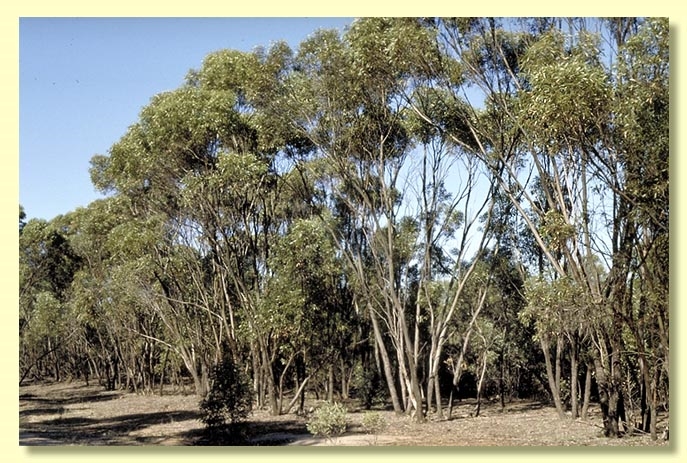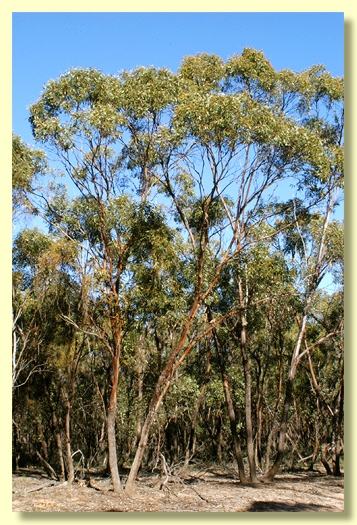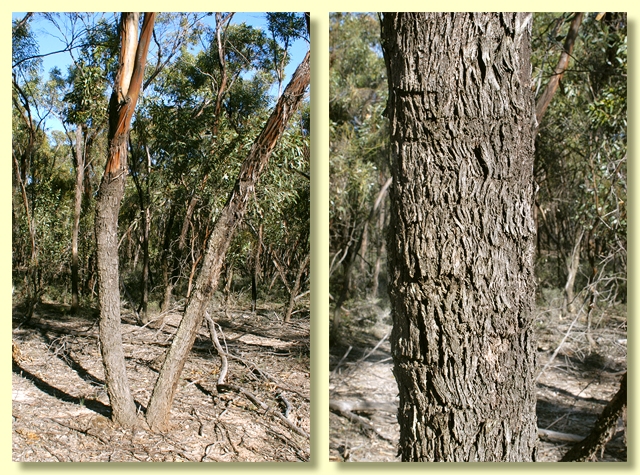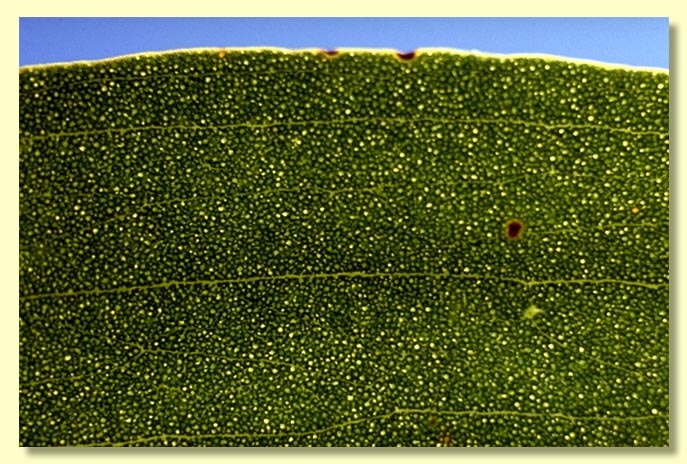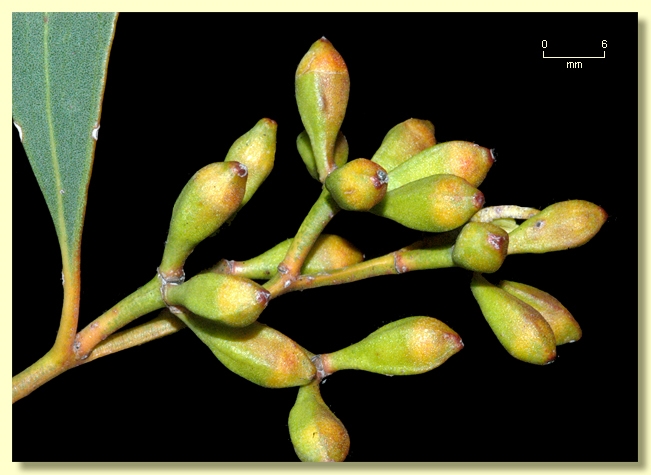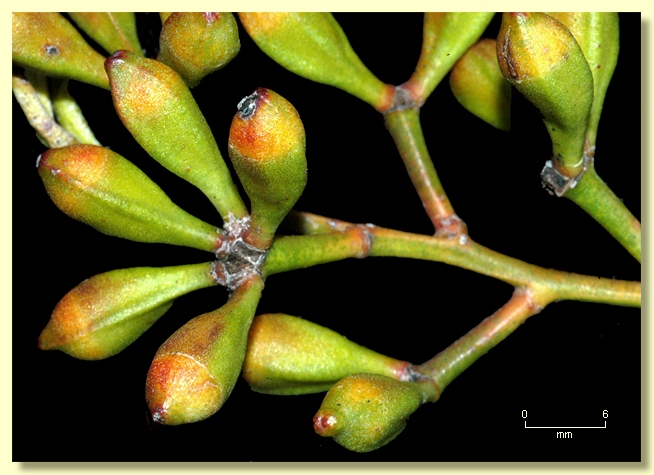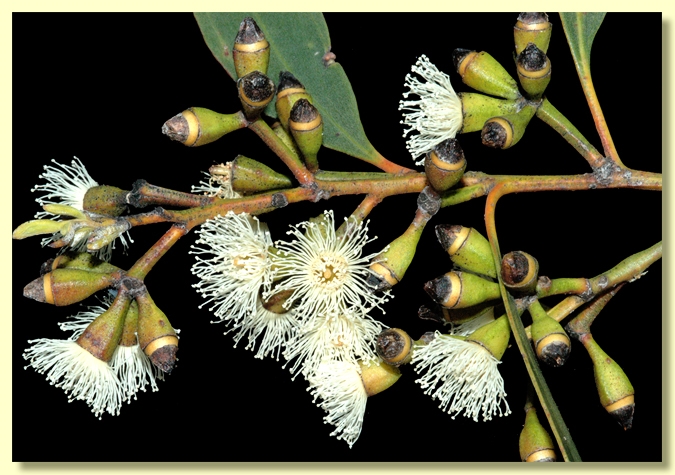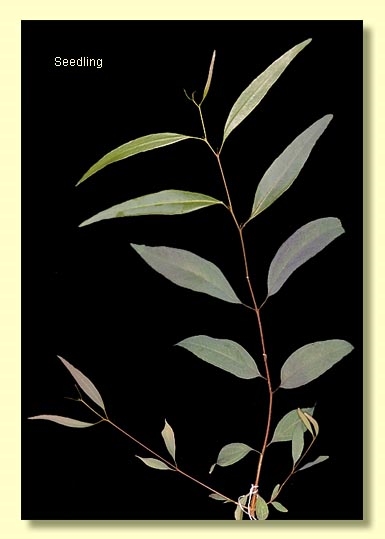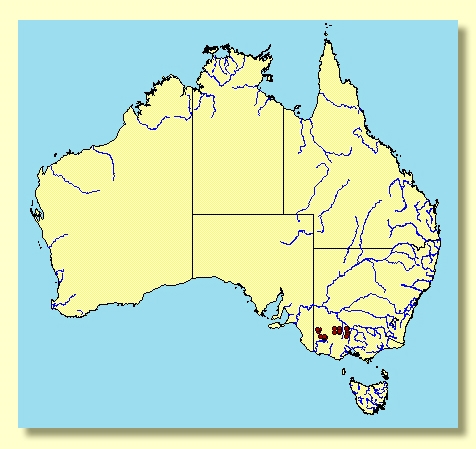Euclid - Online edition
Eucalyptus froggattii
Eucalyptus | Symphyomyrtus | Adnataria | Apicales | Buxeales | Continentes
T: Kamarooka, near Bendigo, Vic., A.W.Howitt s.n.; holo: ?NSW.
Tree or mallee to 10 m tall. Forming a lignotuber.
Bark rough and crumbly over most of trunk, box-type, blackish; smooth bark greenish grey, or green to brown, or yellow-grey, shedding in thin narrow ribbons.
Juvenile growth (coppice or field seedlings to 50 cm): stem rounded or square in cross-section, smooth or slightly warty; juvenile leaves always petiolate, opposite to about node 5 then alternate, petiolate, lanceolate to falcate, 7.8–17.2 cm long, 1.7–2.8 cm wide, dull, blue-green and moderately reticulate up to about node 10, then narrower, glossy green with sparse reticulation.
Adult leaves alternate, petiole 0.5–1.5 cm long; blade lanceolate to falcate, 6.5–13 cm long, 1.2–2.5 cm wide, base tapering to petiole, concolorous, glossy, light green, parallel-veined or side-veins obscure, reticulation absent, intramarginal vein parallel to and remote from margin (sometimes doubled), oil glands very numerous, island.
Inflorescence terminal compound, sometimes with single umbels in upper axils also, peduncles 0.4–1.5 cm long, buds 7, 9 or 11 per umbel, pedicels 0.2–1 cm long. Mature buds square in cross-section, clavate to ovoid to diamond-shaped, 0.7–1 cm long, 0.5–0.7 cm wide, green or red-brown to yellow, with 4 longitudinal ribs, scar absent, operculum pyramidal to conical, stamens irregularly flexed, anthers adnate, globoid to cuboid, dehiscing by small lateral or terminal pores, style long, stigma blunt, locules 4 or 5, the placentae each with 4 vertical ovule rows. Flowers white.
Fruit pedicellate (pedicels 0.2–0.8 cm long), cup-shaped or cylindrical in outline, square in cross-section, 0.6–0.9 cm long, 0.5–0.8 cm wide, 4-ribbed longitudinally, disc descending, valves 4 or 5, enclosed.
Seeds brown or reddish brown, 0.8–1.5 mm long, flattened-ovoid, dorsal surface usually shallowly reticulate, hilum ventral.
Cultivated seedlings (measured at ca node 10): cotyledons oblong to reniform; stems rounded or square in cross-section, smooth or warty; leaves always petiolate, opposite to node 5 or 6 then alternate, lanceolate, 3–13 cm long, 1–3.3 cm wide, base tapering, apex pointed or blunt, lower leaves dull, bluish green, upper leaves glossy, green.
Flowering has been recorded in January, July, September, October, and November.
A mallee box endemic to Victoria, of scattered distribution in north-central and western Victoria, from Bendigo to Charleton and near Nhill. Eucalyptus froggattii is easily distinguished from all other species by the dar-coloured trunk, terminal inflorescences, buds and fruit which are square in section, and by the crown leaves which are crowded with oil glands obscuring most of the venation.
Another unrelated mallee with square buds and fruit is E. calycogona. It is easily distinquished from E. froggattii by the buds having an operculum scar (outer operculum lost early) and the presence of infertile outer stamens (staminodes).
Intergrades of E. froggattii with other box species can occur, e.g. with the narrow-leaved E. viridis and the 'blue-leaved' E. polybractea.
Eucalyptus froggattii belongs in Eucalyptus subgenus Symphyomyrtus section Adnataria (the boxes) because the buds have two opercula, ovules are in four rows, seeds are flattened-ovoid, cotyledons are reniform, and anthers are rigid on the staminal filaments. Within section Adnataria, E. froggattii is part of a subgroup, series Buxeales subseries Continentes, further distinguished by having buds that retain the outer operculum until flowering time when both opercula are shed together. Most species in this group are from eastern Australia and have all stamens fertile and are woodland trees of hills and plains, often dominant in the landscape, viz. E. albens, E. moluccana, E. microcarpa and E. pilligaensis. Others, viz. E. viridis, E. polybractea, E. froggattii, E. odorata, E. albopurpurea, E. sp. Flinders Ranges and E. porosa, are mallees, some of them also occurring as small trees occasionally.

